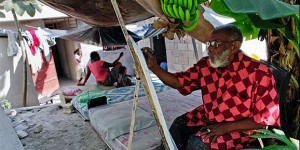
This mini-doc (4 and a half minutes) was part of a series of mini-docs of thirteen artists — masters of Haitian painting and sculpture — who were included in the first major exhibit of Haitian Art in the U.S. at The Brooklyn Museum in 1978. Ute Stebich, the curator of this exhibit of painting, sculpture and papier mache objects, conducted the original interviews that are featured here. The artist videos were part of a video jukebox featured in the galleries where the work was displayed. Two other longer video documentaries were screened on monitors in the galleries — an introduction to Haitian Art and Ra-Ra, a Haitian festival.
The artists included in this video juke box were: Painters: Philome Obin, Rigaud Benoit, Salnave Philippe -Auguste, Jasmin Joseph, Gerard Valcin, Prefete Duffaut, Andre Pierre, Jacques -Enguerrand Gourgue, Bernard Sejourne, Max Gerbier, Celestin Faustin; and the sculptors: Georges Liautaud and Serge Jolimeau.
Prefete Duffaut — like most of the artists featured in this exhibit — came from humble origins. And, like many of his colleagues, he began painting from his rich spiritual imagination — influenced by Christianity and voodou. He like a number of the other painters his age were discovered by Dewitt Peters who established the Centre D’Arte in Port-au-Prince in the 1940’s, 50’s and 60s nurturing and selling the works of Haiti’s indigenous and largely untrained talent. In this mini-doc Duffaut explains that he started painting with shoe polish and guinea hen feathers and he describes the overwhelming joy when he sold his first paintings to Peters. It was more money than his family had ever seen. At the time of this production, Duffaut’s paintings were usually identified by the series of imaginary mountains criss-crossed by roads and a variety of Christian and voodou symbolism. He was also one of the group of first generation naif painters who participated in the painting of the famous murals in Holy Trinity Cathedral in Port-au-Prince.


HI MY NAME IS JEAN CHARLES DUFFAUT AM PREFETE’S SON, I JUST WANNA SAY
> THANK YOU FOR THIS OLD VIDEO THAT YOU GUYS POSTED ON YR PAGE.ITS FEEL
> SO GOOD TO WATCH IT AND IT BRINGS BACK MEMORIES AND I REMEMBER THIS
> VIDEO I WAS 8 Y/O AND I WAS THERE WHEN THEY CAME TO PICK UP MY
> DAD AT JACMEL TO DO IT,THANK YOU ,THANK YOU FOR POSTED IT,HERE IS MY WEBSITE http://WWW.DUFOART.WEBS.COM
Duffaut is an abstract artist with a genius for composition underlying the subject matter. I don’t know many artists both this good and this accessible. This is a very important video. I hope one can find the other eleven videos in this series.
I am very honored to have met Prefete and will always remember his smile and love that was shown through his talent and family!! He will be missed and always loved!
I grew up with him, he is part of who i am today i will never forget about him. He was a loving step-dad. He was famous and i am happy to have to see him again. Thank you all for this video.
Sept,22,2015
I own an original painting by Duffaut painted in 1950s. it is signed “Souve-Nir Madame Prefete Duffaut.” Does anyone have information about paintings he did for his wife. why would he sell it to my step mother during her trip in the ’50s?
Thank you for visiting my website. I cannot answer your question, but I have posted your query so that somebody else checking out the site may be able to respond. Gail Pellett
I’m the grandchild of Duffaut I want to say thank you for all the videos you posted
How wonderful to hear from you Ander Pierre! I have very fond memories of that time meeting your grandfather in Jacmel (1977-78) and then traveling with him to the mountains outside the town. I probably met him originally at the Centre D’art. Then at his studio in Jacmel. Please let me know by email if he is still alive and if so, where he is living and how he is. Thank you! gpellett4@gmail.com